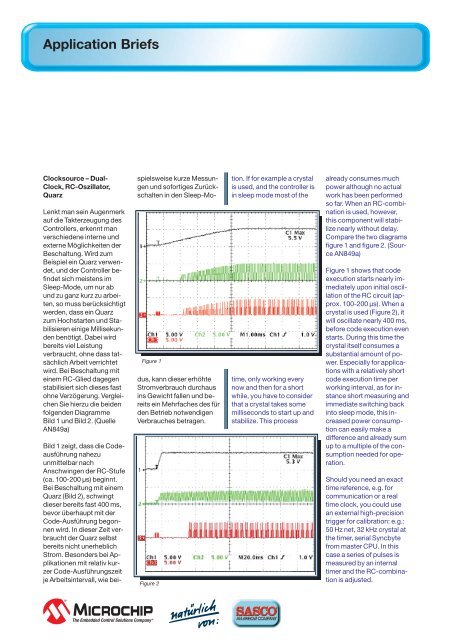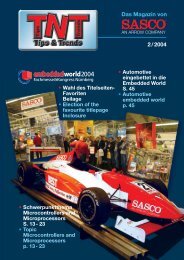SASCO Information & News - ISI-Design
SASCO Information & News - ISI-Design
SASCO Information & News - ISI-Design
Erfolgreiche ePaper selbst erstellen
Machen Sie aus Ihren PDF Publikationen ein blätterbares Flipbook mit unserer einzigartigen Google optimierten e-Paper Software.
Application Briefs<br />
Clocksource – Dual-<br />
Clock, RC-Oszillator,<br />
Quarz<br />
Lenkt man sein Augenmerk<br />
auf die Takterzeugung des<br />
Controllers, erkennt man<br />
verschiedene interne und<br />
externe Möglichkeiten der<br />
Beschaltung. Wird zum<br />
Beispiel ein Quarz verwendet,<br />
und der Controller befindet<br />
sich meistens im<br />
Sleep-Mode, um nur ab<br />
und zu ganz kurz zu arbeiten,<br />
so muss berücksichtigt<br />
werden, dass ein Quarz<br />
zum Hochstarten und Stabilisieren<br />
einige Millisekunden<br />
benötigt. Dabei wird<br />
bereits viel Leistung<br />
verbraucht, ohne dass tatsächlich<br />
Arbeit verrichtet<br />
wird. Bei Beschaltung mit<br />
einem RC-Glied dagegen<br />
stabilisiert sich dieses fast<br />
ohne Verzögerung. Vergleichen<br />
Sie hierzu die beiden<br />
folgenden Diagramme<br />
Bild 1 und Bild 2. (Quelle<br />
AN849a)<br />
Bild 1 zeigt, dass die Codeausführung<br />
nahezu<br />
unmittelbar nach<br />
Anschwingen der RC-Stufe<br />
(ca. 100-200 µs) beginnt.<br />
Bei Beschaltung mit einem<br />
Quarz (Bild 2), schwingt<br />
dieser bereits fast 400 ms,<br />
bevor überhaupt mit der<br />
Code-Ausführung begonnen<br />
wird. In dieser Zeit verbraucht<br />
der Quarz selbst<br />
bereits nicht unerheblich<br />
Strom. Besonders bei Applikationen<br />
mit relativ kurzer<br />
Code-Ausführungszeit<br />
je Arbeitsintervall, wie bei-<br />
spielsweise kurze Messungen<br />
und sofortiges Zurückschalten<br />
in den Sleep-Mo-<br />
Figure 1<br />
dus, kann dieser erhöhte<br />
Stromverbrauch durchaus<br />
ins Gewicht fallen und bereits<br />
ein Mehrfaches des für<br />
den Betrieb notwendigen<br />
Verbrauches betragen.<br />
Figure 2<br />
tion. If for example a crystal<br />
is used, and the controller is<br />
in sleep mode most of the<br />
time, only working every<br />
now and then for a short<br />
while, you have to consider<br />
that a crystal takes some<br />
milliseconds to start up and<br />
stabilize. This process<br />
already consumes much<br />
power although no actual<br />
work has been performed<br />
so far. When an RC-combination<br />
is used, however,<br />
this component will stabilize<br />
nearly without delay.<br />
Compare the two diagrams<br />
figure 1 and figure 2. (Source<br />
AN849a)<br />
Figure 1 shows that code<br />
execution starts nearly immediately<br />
upon initial oscillation<br />
of the RC circuit (approx.<br />
100-200 µs). When a<br />
crystal is used (Figure 2), it<br />
will oscillate nearly 400 ms,<br />
before code execution even<br />
starts. During this time the<br />
crystal itself consumes a<br />
substantial amount of power.<br />
Especially for applications<br />
with a relatively short<br />
code execution time per<br />
working interval, as for instance<br />
short measuring and<br />
immediate switching back<br />
into sleep mode, this increased<br />
power consumption<br />
can easily make a<br />
difference and already sum<br />
up to a multiple of the consumption<br />
needed for operation.<br />
Should you need an exact<br />
time reference, e.g. for<br />
communication or a real<br />
time clock, you could use<br />
an external high-precision<br />
trigger for calibration: e.g.:<br />
50 Hz net, 32 kHz crystal at<br />
the timer, serial Syncbyte<br />
from master CPU. In this<br />
case a series of pulses is<br />
measured by an internal<br />
timer and the RC-combination<br />
is adjusted.




